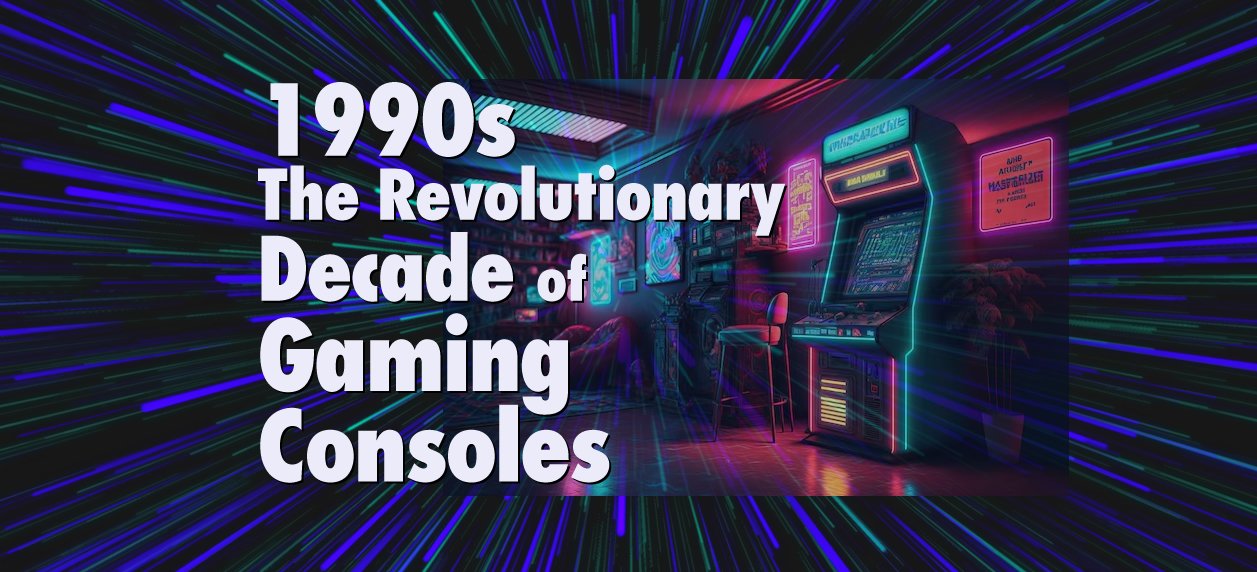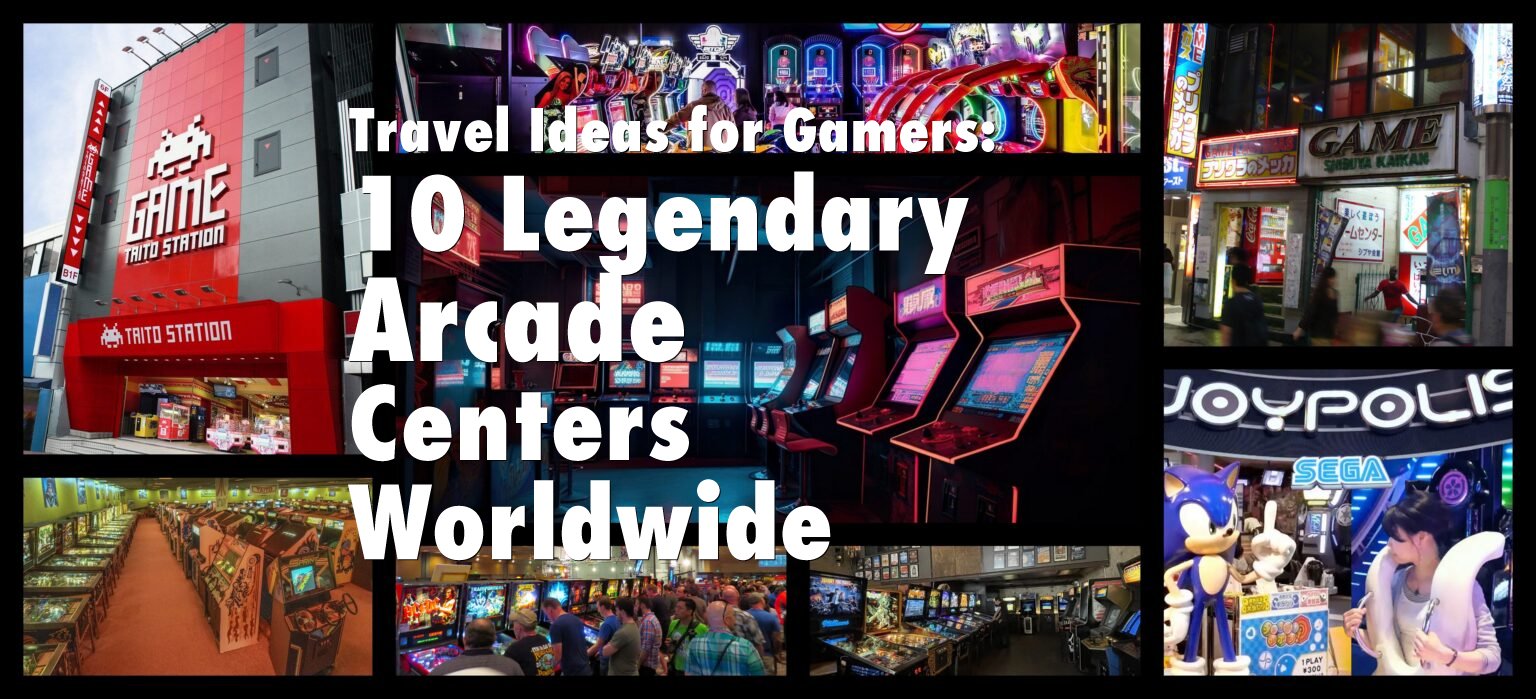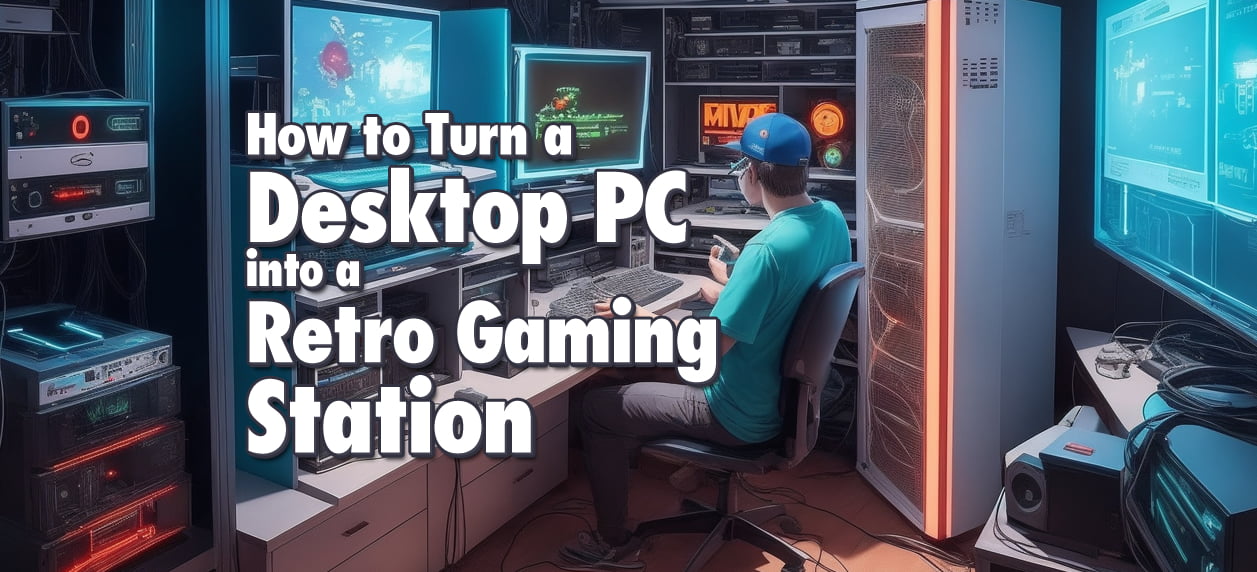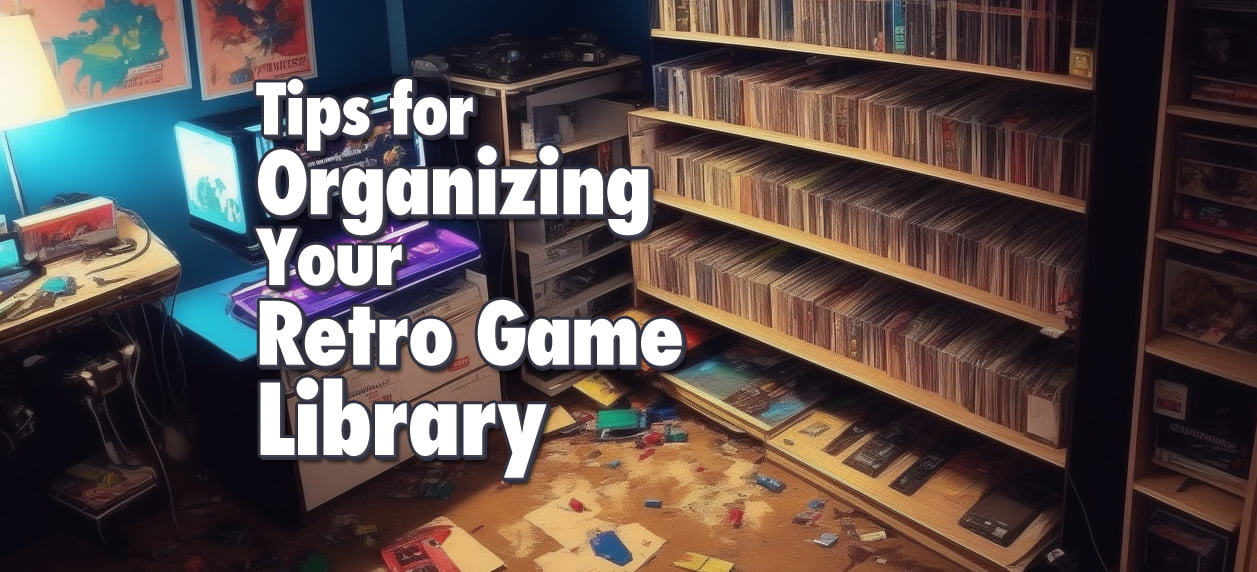The world of gaming has come a long way since its inception, and the 90's witnessed the rise of iconic video game consoles that left an indelible mark on gaming history.
The 1990s was an era of seismic shifts and groundbreaking innovations in the world of gaming. It was a time when gaming consoles transformed from simple entertainment devices into cultural phenomena, forever altering the way we played, connected, and experienced video games.
Table of Contents
Join us on a nostalgic journey as we revisit the consoles that defined this revolutionary decade. From the Super Nintendo's 16-bit magic to Sony's foray into 3D gaming with the PlayStation, each console had a unique story to tell. The 1990s left an indelible mark on gaming history, and it all started with these iconic machines:
Super Nintendo Entertainment System (SNES): The Golden Era of Gaming

Release date: August 23, 1991 (North America)
In the early 1990s, the gaming world witnessed a dramatic evolution with the arrival of the Super Nintendo Entertainment System (SNES). Often simply referred to as the Super Nintendo, this 16-bit marvel burst onto the scene as the successor to the beloved Nintendo Entertainment System (NES). With its expanded color palette, improved graphics, and a library of games that would become legendary, the SNES forever altered the gaming landscape.
The SNES wasn't just a console; it was a portal to fantastical worlds and unforgettable adventures. It introduced us to beloved characters like Mario, Link, and Samus in games like “Super Mario World,” “The Legend of Zelda: A Link to the Past,” and “Super Metroid.” These titles were not just games; they were immersive experiences that captivated players young and old.
With its iconic controller and the introduction of the “L” and “R” buttons, the SNES set the standard for comfortable and intuitive gaming interfaces. It encouraged hours of exploration, puzzle-solving, and cooperative play, bringing friends and families together in the pursuit of high scores and epic quests.
As we delve into the 1990s, prepare to embark on a journey through the 16-bit era, where innovation, creativity, and nostalgia collide. The Super Nintendo Entertainment System stands as a testament to the enduring power of great games and the joy they continue to bring to players worldwide.
👍 PROS
- Iconic Franchises: The SNES introduced gamers to timeless franchises like Super Mario, The Legend of Zelda, and Metroid. These titles set the foundation for beloved series that continue to captivate gamers to this day.
- Graphics and Sound: With its Mode 7 graphics technology and advanced sound capabilities, the SNES raised the bar for visual and audio quality in gaming. Games like Super Mario World showcased vibrant colors and intricate details.
- Two-Player Action: Many SNES titles offered two-player co-op or competitive gameplay, enhancing the social aspect of gaming. Games like Street Fighter II and Super Mario Kart became staples for multiplayer fun.
👎 CONS
- Limited 3D Capabilities: While the SNES was a pioneer in 2D gaming, it lacked the 3D capabilities that later consoles would offer. This limitation prevented the console from fully embracing emerging trends in game design.
- Hardware Aging: As time went on, the SNES's hardware limitations became more evident, making it challenging to keep up with the technological advancements of newer consoles.
- No Built-in Save Feature: Many early SNES games lacked a built-in save feature, requiring players to rely on passwords or external devices to continue their progress.
🕹️ TOP 10 SNES GAMES

- Super Mario World
- The Legend of Zelda: A Link to the Past
- Super Metroid
- Chrono Trigger
- Street Fighter II
- Super Mario Kart
- Donkey Kong Country
- Final Fantasy VI (III in the US)
- Super Mario RPG: Legend of the Seven Stars
- Mega Man X
Sega Genesis – Blast Processing and Beyond

Launch Date: August 14, 1989 (North America)
In the fierce console wars of the early 1990s, the Sega Genesis emerged as a dynamic and daring contender. Known as the Sega Mega Drive outside North America, this 16-bit powerhouse was more than just a console; it was a statement. Sega was ready to challenge the status quo and redefine what gaming meant.
The Genesis introduced players to the lightning-fast hedgehog, Sonic, who raced onto the scene as Sega's mascot, giving Mario a run for his coins. Sonic's blistering speed and attitude embodied the Genesis's edgier approach to gaming. With games like “Sonic the Hedgehog,” “Streets of Rage 2,” and “Phantasy Star IV,” the Genesis captured the imaginations of gamers worldwide.
But the Genesis wasn't just about Sonic. It boasted a diverse library of titles, including sports games, RPGs, and beat 'em ups. Titles like “Golden Axe” and “Shining Force II” showcased the system's versatility and commitment to providing unique gaming experiences.
With its iconic “Sega!” startup sound and distinctive black design, the Genesis remains an indelible part of gaming history. As we explore the 1990s, we'll discover how the Sega Genesis, fueled by innovation and a rebel spirit, played a pivotal role in shaping the gaming landscape of its time.
👍 PROS
- Sonic the Hedgehog: The introduction of Sonic the Hedgehog brought a fresh, speedy mascot to the gaming scene, challenging Mario's dominance. The “Blast Processing” technology enhanced Sonic's gameplay speed.
- Unique Titles: The Sega Genesis had its own set of exclusive titles, such as the Streets of Rage series and Phantasy Star, which appealed to gamers seeking unique experiences.
- Sega's Marketing: Sega's bold “Genesis does what Nintendon't” marketing campaign created a memorable rivalry between Sega and Nintendo, sparking innovation and competition.
👎 CONS
- Limited Color Palette: The Sega Genesis had a smaller color palette compared to its competitors, affecting the visual quality and range of colors in games.
- Fewer Popular Exclusives: While the Sega Genesis had unique titles, it struggled to match the sheer number of popular exclusives that its competitors, like Nintendo, offered.
- Sound Quality: Despite advancements in sound technology, the Genesis sometimes struggled to produce the same level of audio quality as its competitors.
🕹️ TOP 10 Sega Genesys GAMES

- Sonic the Hedgehog
- Streets of Rage 2
- Phantasy Star IV
- Gunstar Heroes
- Shining Force II
- Castlevania: Bloodlines
- Sonic the Hedgehog 2
- Aladdin
- Mortal Kombat II
- Ecco the Dolphin
🕹️ Explore our store for Home & Handheld Retro Gaming Console Deals.
Sony PlayStation – Where 3D Gaming Dreams Came to Life

Launch Date: December 3, 1994 (Japan); September 9, 1995 (North America)
As the 1990s progressed, the gaming landscape experienced a seismic shift with the arrival of the Sony PlayStation. Breaking free from the traditional cartridge-based gaming of its predecessors, the PlayStation introduced the world to the power of CD-ROMs and 3D gaming. This sleek, gray console became more than just a gaming device; it marked the beginning of a new era in interactive entertainment.
The PlayStation was more than a hardware upgrade; it was a revolution. It offered a vast library of games that pushed the boundaries of storytelling, graphics, and gameplay. Titles like “Final Fantasy VII” and “Metal Gear Solid” not only redefined their respective genres but also elevated gaming to an art form. Players weren't just controlling characters; they were immersed in epic adventures and intricate narratives.
The introduction of the DualShock controller, with its analog sticks and rumble feedback, changed how gamers interacted with their virtual worlds. It allowed for finer control and tactile feedback, enhancing the overall gaming experience.
As we step into the world of the PlayStation, get ready to explore the 1990s from a new perspective—one where gaming was not just a pastime but an art form and a source of deeply emotional experiences. The PlayStation's sleek design, groundbreaking games, and commitment to innovation left an indelible mark on the industry, and its impact continues to resonate with gamers worldwide.
👍 PROS
- 3D Revolution: The Sony PlayStation ushered in the era of 3D gaming, providing gamers with immersive experiences in a new dimension. Titles like Crash Bandicoot and Metal Gear Solid showcased the potential of 3D graphics.
- CD Format: The PlayStation's CD format allowed for larger game sizes, enabling developers to create more expansive and cinematic gaming experiences.
- Innovative Titles: The PlayStation introduced innovative titles like Parappa the Rapper and Twisted Metal that pushed the boundaries of game design and mechanics.
👎 CONS
- Lack of Backward Compatibility: The PlayStation lacked backward compatibility with earlier Sony consoles, making it impossible to play older titles without keeping multiple systems.
- Disc Read Errors: The PlayStation was susceptible to disc read errors, which could disrupt gameplay and lead to frustration.
- No Dual Analog Sticks: The original PlayStation controller lacked dual analog sticks, limiting the range of controls available for certain games.
🕹️ TOP 10 Sony PlayStation GAMES

- Final Fantasy VII
- Metal Gear Solid
- Resident Evil 2
- Castlevania: Symphony of the Night
- Crash Bandicoot
- Tomb Raider
- Final Fantasy IX
- Gran Turismo
- Tekken 3
- Tony Hawk's Pro Skater
Nintendo 64 – Unlocking 3D Worlds

Launch Date: June 23, 1996 (Japan); September 9, 1995 (North America)
The Nintendo 64, affectionately known as the N64, emerged as a technological marvel in the mid-1990s. With its distinctive three-pronged controller and revolutionary 3D graphics, this console signaled a bold new direction for gaming. It was a testament to Nintendo's dedication to pushing the boundaries of what was possible in the world of interactive entertainment.
At the heart of the N64's appeal were its groundbreaking games. “The Legend of Zelda: Ocarina of Time” and “Super Mario 64” set new standards for 3D gameplay and storytelling. Gamers marveled at the immersive worlds and intricate puzzles these titles offered.
The N64 also played a pivotal role in the rise of multiplayer gaming. With its four controller ports, it facilitated memorable gaming sessions with friends, whether racing in “Mario Kart 64,” duking it out in “Super Smash Bros.,” or fragging opponents in “GoldenEye 007.”
This console wasn't just a piece of hardware; it was an invitation to explore uncharted territories of creativity and imagination. As we delve into the N64 era, we'll uncover how it redefined gaming in the 1990s, leaving us with cherished memories and a legacy of innovation that continues to inspire the gaming industry.
👍 PROS
- Groundbreaking 3D Gameplay: The Nintendo 64 brought 3D gaming to a new level with titles like Super Mario 64 and The Legend of Zelda: Ocarina of Time, setting standards for exploration and gameplay mechanics.
- Innovative Analog Stick: The introduction of the analog stick on the Nintendo 64 controller allowed for precise control and nuanced movements in games, enhancing gameplay experiences.
- Local Multiplayer: The Nintendo 64's four controller ports encouraged local multiplayer experiences, with games like Mario Kart 64 and Super Smash Bros. becoming legendary party games.
👎 CONS
- Limited Storage Capacity: The cartridge-based format of the Nintendo 64 limited the storage capacity for games, leading to compromises in game content and visuals.
- Expensive Cartridges: The production costs of Nintendo 64 cartridges were higher compared to optical discs, making games more expensive to produce and purchase.
- Complex Cartridges: Developing games on cartridges proved challenging due to their complexity, often leading to longer development cycles and delays.
🕹️ TOP 10 Nintendo 64 GAMES

- The Legend of Zelda: Ocarina of Time
- Super Mario 64
- GoldenEye 007
- Mario Kart 64
- Banjo-Kazooie
- Super Smash Bros.
- Star Fox 64
- Perfect Dark
- Paper Mario
- Donkey Kong 64
Sega Dreamcast – Sega's Final Console Legacy

Launch Date: November 27, 1998 (Japan); September 9, 1999 (North America)
The turn of the millennium brought with it the Sega Dreamcast, a console that dared to dream big. It was a swan song for Sega's foray into the console market, and it made quite an impact in its short lifespan.
The Dreamcast was a pioneer in many ways. It was the first console to embrace online gaming with titles like “Sonic Adventure” and “Phantasy Star Online,” offering players a glimpse of the interconnected gaming future that lay ahead. Its innovative controller, the Visual Memory Unit (VMU), introduced a unique second-screen experience.
With games like “Shenmue” and “Soulcalibur,” the Dreamcast showcased its graphical prowess and penchant for arcade-quality experiences. It was a platform that was unafraid to take creative risks, as seen in games like “Jet Set Radio” and “Space Channel 5.”
Despite its relatively short-lived presence in the gaming world, the Sega Dreamcast remains a beloved cult classic, remembered for its innovation, eclectic game library, and the sense of endless possibilities it ignited.
As we step into the Dreamcast era, we'll explore how this console's innovation and ambition shaped the gaming landscape of the late 1990s and early 2000s, leaving an indelible mark on the industry and the hearts of gamers.
👍 PROS
- Online Capabilities: The Dreamcast was ahead of its time with its built-in modem, allowing gamers to play online multiplayer games and access web content.
- Unique Titles: Games like Shenmue showcased the Dreamcast's ability to deliver immersive storytelling experiences that stood out from the crowd.
- VMU Integration: The Visual Memory Unit (VMU) added a new layer of interactivity, allowing players to carry game progress, mini-games, and even small apps on a portable device.
👎 CONS
- Short Console Life: The Dreamcast's short lifespan was due to competition from upcoming consoles like the PlayStation 2 and Xbox, leading to a limited library of games.
- Limited Third-Party Support: Despite its innovative features, the Dreamcast struggled to secure strong third-party support, limiting the variety of games available.
- Lack of DVD Playback: Unlike its competitors, the Dreamcast lacked DVD playback capabilities, which became a significant multimedia feature for gaming consoles.
🕹️ TOP 10 Sega DreamCast GAMES

- Sonic Adventure
- Shenmue
- Soulcalibur
- Jet Set Radio
- Resident Evil Code: Veronica
- Crazy Taxi
- Skies of Arcadia
- Power Stone
- Tony Hawk's Pro Skater 2
- Marvel vs. Capcom 2
🔥 Check out our Shop to find the latest amazing
🕹️ retro gaming consoles deals.
Conclusion: Unfolding the Console Revolution of the 1990s
The 1990s was an exhilarating era in the world of gaming, marked by the emergence of consoles that would forever change the way we played and experienced video games. As we've journeyed through the annals of this decade, we've uncovered a landscape rich with innovation, fierce competition, and unforgettable gaming moments.
The '90s witnessed a shift from 8-bit to 16-bit gaming with the Super Nintendo and Sega Genesis, setting the stage for an era of graphics and gameplay that felt truly transformative. These consoles introduced us to beloved characters like Mario and Sonic, who became iconic figures in the gaming world.
The PlayStation arrived as a disruptor, introducing CD-ROM technology and 3D gaming, propelling gaming into the realm of immersive storytelling and cinematic experiences. The Nintendo 64 redefined 3D gaming with titles like “The Legend of Zelda: Ocarina of Time” and “Super Mario 64,” while the Sega Dreamcast pushed the boundaries of online play.
We've explored the rise of online gaming with the Dreamcast and the beginning of online communities with Xbox Live on the original Xbox. We've marveled at the versatility and unique features of each console, from the DualShock controller to the Sega Dreamcast's VMU.
But this journey isn't just about technology; it's about memories. It's about the late-night gaming sessions with friends, the excitement of unboxing a new console, and the triumph of defeating a challenging boss. It's about the sense of wonder that these consoles ignited within us, a sense of wonder that continues to thrive in the hearts of gamers today.
The console revolution of the 1990s wasn't just about gaming; it was about the cultural impact, the friendships forged, and the stories told. It was a decade that left an indelible mark on the industry, a mark that still influences gaming trends and innovations today.
As we conclude this journey through the console revolution of the 1990s, we're reminded that gaming isn't just a hobby; it's a part of our collective history and a canvas for endless creativity. The '90s consoles were the vehicles that transported us to new worlds, and the experiences we had within those worlds have become cherished memories that continue to shape our passion for gaming.
So, whether you're a seasoned gamer who remembers the '90s with fondness or a newcomer curious about the roots of modern gaming, remember that the spirit of innovation, competition, and camaraderie that defined this era is still very much alive in today's gaming landscape. As we move forward into the future, let's not forget to celebrate the consoles and the games that paved the way, for they are the reason we can embark on new gaming adventures, building upon the legacy of the '90s with excitement and anticipation.
These consoles from 1990's represent not just technological achievements but also the cultural and creative spirit of their times. They defined the gaming landscape of a extraordinary decade, leaving indelible marks on the industry and the hearts of gamers. As we explore their legacies, we'll uncover the stories, innovations, and gaming moments that continue to resonate with players today.
Understanding the evolution of these consoles helps us appreciate the innovations that have paved the way for the gaming experiences we enjoy today.
Subscribe today for exclusive gaming updates. Be a part of the digital revolution!
The Best Modern Emulating Consoles for Playing Retro Video Games Today
Thanks to the rapid advancement of technology, affordable emulators console replicas are readily available today. These modern marvels allow us to relive the magic of those classic gaming days right on our modern home TV screens and computers thanks to emulator software. Imagine the excitement of introducing your favorite retro games to family members, sharing the experiences that brought joy to your own childhood. With a controller in hand and memories in your heart, you can bridge the generational gap and create new moments of joy and laughter.
At CoolGeekLab Shop we selected a stunning collection of the the best Home Tv Retro Consoles & Handheld emulators devices available today with thousands of classic retro videogames pre-installed at discounted prices.
So, whether you're diving into pixelated adventures of the past or conquering 8-bit challenges with your loved ones, the world of retro gaming continues to thrive. The journey from 1990 to 2010 was just the beginning, and the echoes of those gaming revolutions still resonate today.





🕹️ Explore our store for Home & Handheld Retro Gaming Console Deals.




